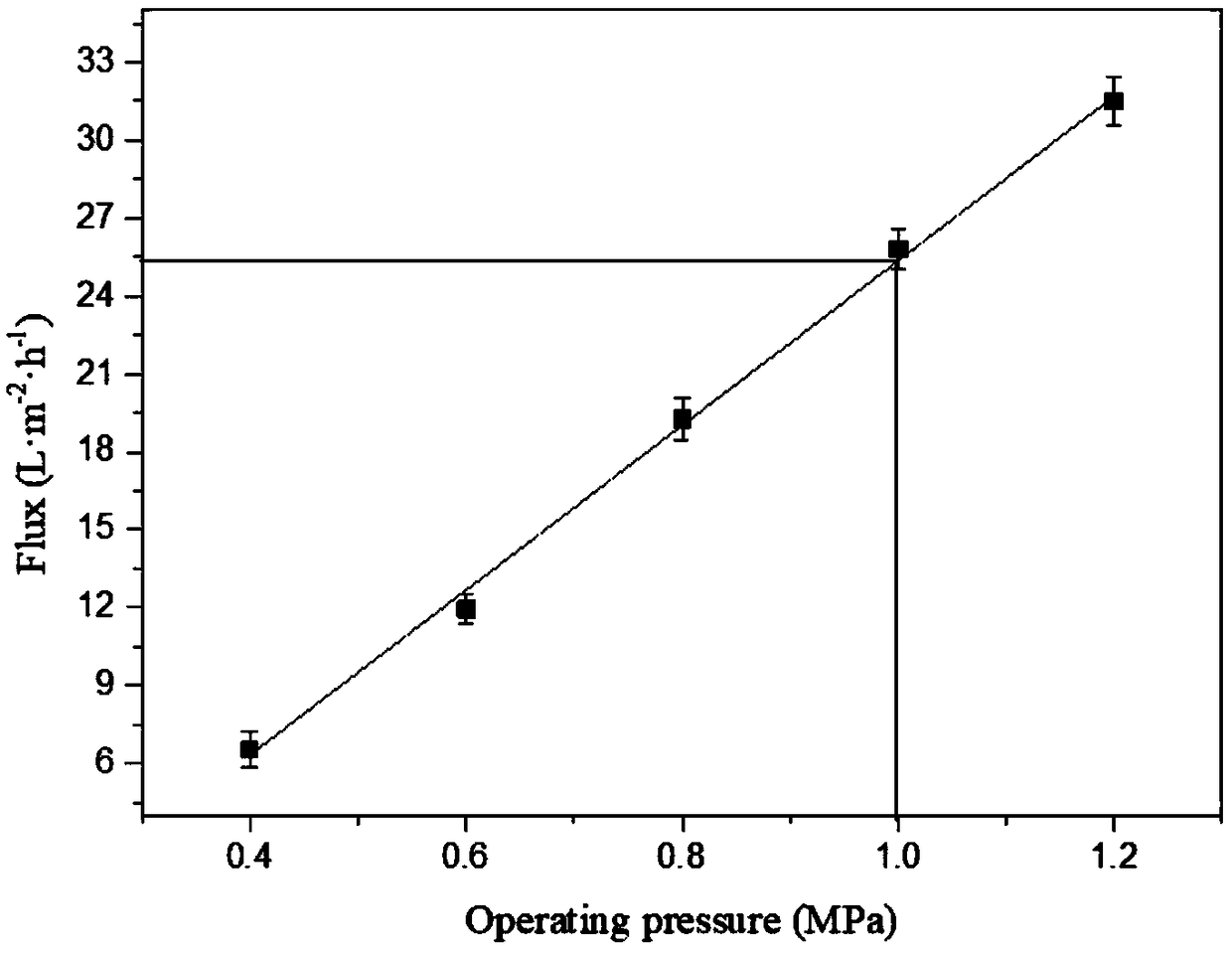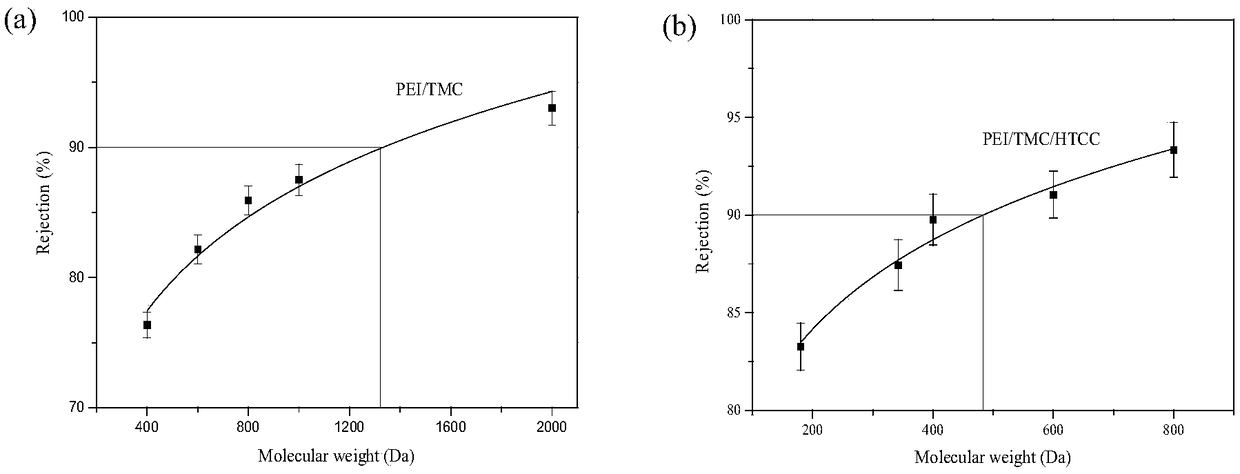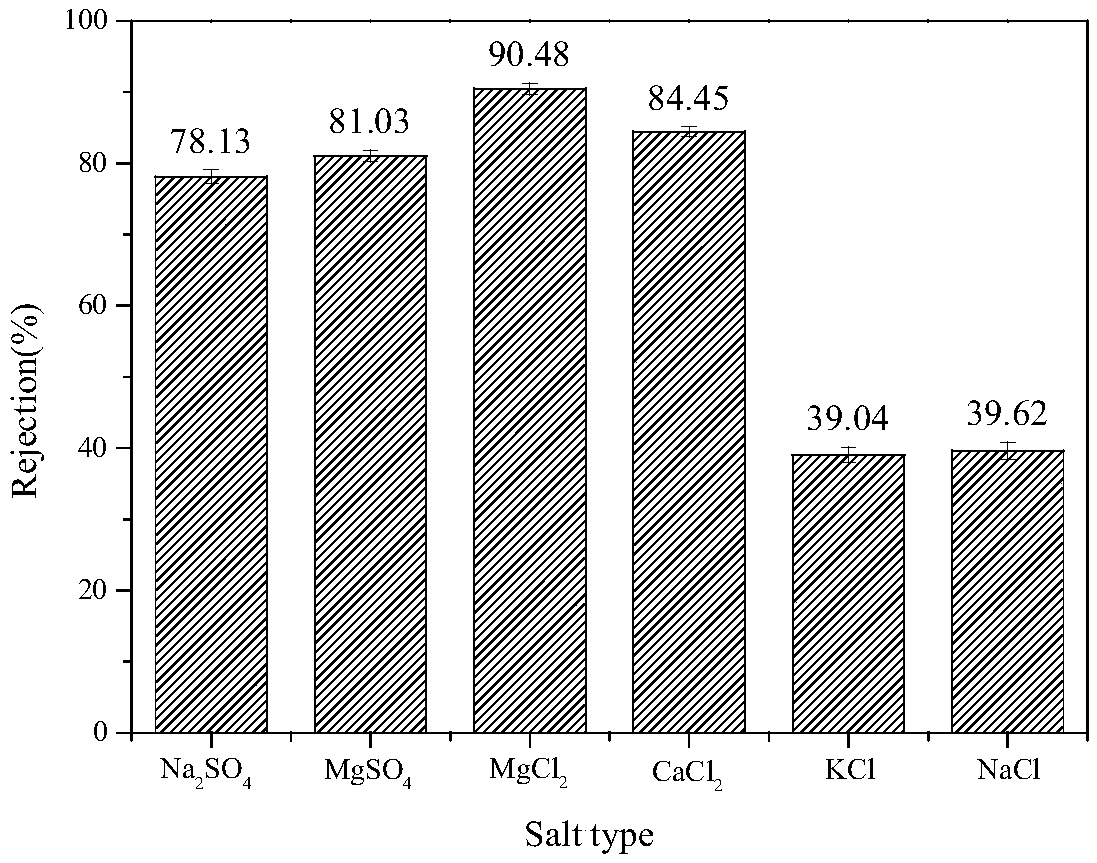A method for preparing a nanofiltration membrane used for removing divalent cation and PPCPs with positive charges
A divalent cation, positively charged technology, applied in chemical instruments and methods, membrane technology, semi-permeable membrane separation, etc., can solve the problems of high price of hyperbranched polyethyleneimine, loose polyamide structure, etc. The effect of high volume, low cost and good retention performance
- Summary
- Abstract
- Description
- Claims
- Application Information
AI Technical Summary
Problems solved by technology
Method used
Image
Examples
Embodiment 1
[0032] Prepare PEI aqueous solution with mass concentration of 0.5%, 1%, 1.5%, 2%, 2.5%, 3%, containing additives SDS, Na 2 CO 3 The mass concentration is 0.1%, take 12 PES ultrafiltration membranes, first wash the PES ultrafiltration membranes with ultrapure water before interfacial polymerization, and then use , 3% PEI solution respectively immersed in two films, take out after 20min, use a rubber roller to remove the excess PEI mixture on the surface of the film, immerse the film in n-hexane solution with a mass concentration of 0.2% TMC, take it out after reacting for 5min, wait for After the excess n-hexane solution on the obtained composite membrane was evaporated naturally in the air, it was placed in an oven at a temperature of 50°C to dry until after drying, two composite membranes with six different PEI concentrations were obtained.
[0033] The PEI / TMC composite membranes prepared under the conditions of 0.5%, 1%, 1.5%, 2%, 2.5%, and 3% PEI aqueous solution were re...
Embodiment 2
[0035] Prepare a PEI aqueous solution with a mass concentration of 1.5%, containing additives SDS, Na 2 CO 3 The mass concentration is 0.1%. Take 12 PES ultrafiltration membranes. First, wash the PES ultrafiltration membranes with ultrapure water before interfacial polymerization, and then immerse them in the PEI solution with a mass concentration of 1.5%. After soaking for 5min, 10min, and 15min , 20min, 25min, and 30min, take out the two films respectively, use a rubber roller to remove the excess PEI mixture on the surface of the film after taking out, immerse the film in a n-hexane solution with a mass concentration of 0.2% TMC, take it out after reacting for 5 minutes, and the obtained After the excess n-hexane solution on the composite membrane was evaporated naturally in the air, it was placed in an oven at a temperature of 50°C until it was dried and taken out to obtain 2 composite membranes obtained under 6 different PEI immersion times.
[0036] The composite membra...
Embodiment 3
[0038] Prepare a PEI aqueous solution with a mass concentration of 1.5%, containing additives SDS, Na 2 CO 3 The mass concentration is 0.1%. Take 14 PES ultrafiltration membranes. First, wash the PES ultrafiltration membranes with ultrapure water before interfacial polymerization, and then immerse them in the PEI solution with a mass concentration of 1.5%. Take them out after soaking for 20 minutes. Finally, use a rubber roller to remove the excess PEI mixture on the surface of the membrane, immerse the membrane in a n-hexane solution with a mass concentration of 0.2% TMC, and react in turn for 1min, 2min, 3min, 4min, 5min, 6min, 7min each two, after the reaction is completed Take it out, after the excess n-hexane solution on the obtained composite membrane membrane evaporates naturally in the air, put it in an oven with a temperature of 50°C and dry it until it is dried, and then take it out to obtain 7 kinds of composite membranes obtained under different TMC immersion times...
PUM
| Property | Measurement | Unit |
|---|---|---|
| surface roughness | aaaaa | aaaaa |
| molecular weight | aaaaa | aaaaa |
| degree of substitution | aaaaa | aaaaa |
Abstract
Description
Claims
Application Information
 Login to View More
Login to View More - R&D
- Intellectual Property
- Life Sciences
- Materials
- Tech Scout
- Unparalleled Data Quality
- Higher Quality Content
- 60% Fewer Hallucinations
Browse by: Latest US Patents, China's latest patents, Technical Efficacy Thesaurus, Application Domain, Technology Topic, Popular Technical Reports.
© 2025 PatSnap. All rights reserved.Legal|Privacy policy|Modern Slavery Act Transparency Statement|Sitemap|About US| Contact US: help@patsnap.com



